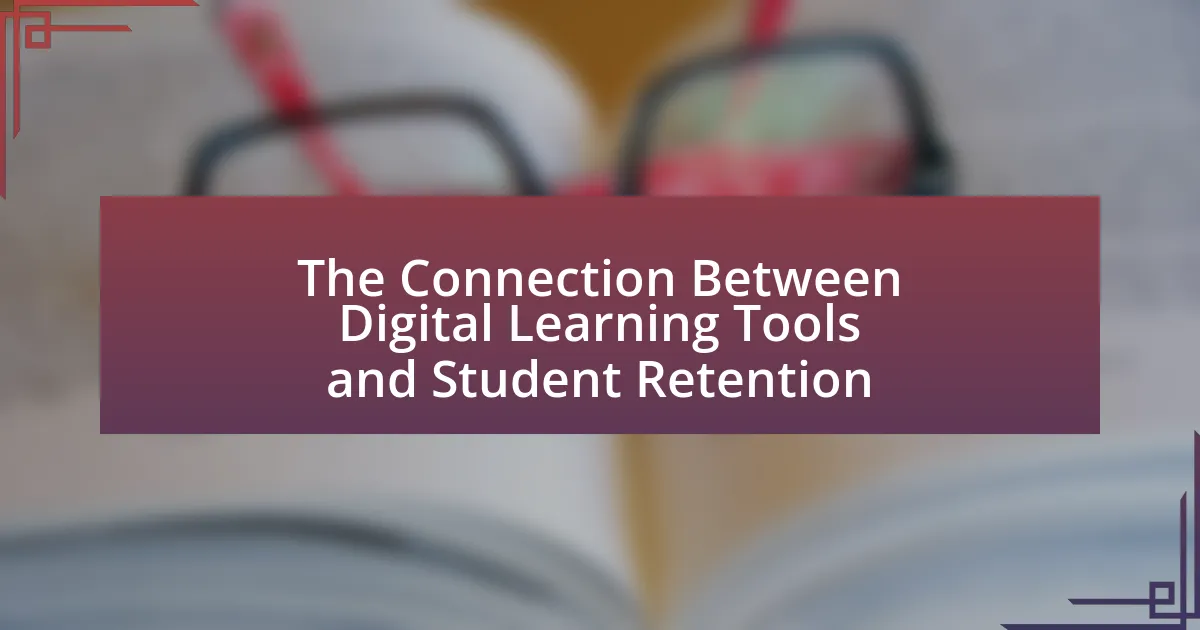Interactive video is a pivotal component of distance education, significantly enhancing learner engagement and retention through interactive features such as quizzes, polls, and clickable content. Research indicates that this format can increase student engagement by up to 70% and improve retention rates by as much as 60% compared to traditional video formats. The article explores how interactive video facilitates active learning, caters to diverse learning styles, and addresses the challenges of implementation in educational settings. Additionally, it highlights best practices for educators in creating effective interactive video content and strategies for maximizing student motivation and engagement.

What is the Role of Interactive Video in Distance Education?
Interactive video plays a crucial role in distance education by enhancing engagement and facilitating active learning. It allows learners to interact with content through features such as quizzes, polls, and clickable elements, which can lead to improved retention of information. Research indicates that interactive video can increase learner engagement by up to 70%, as it encourages participation and provides immediate feedback. This interactive approach not only makes learning more dynamic but also caters to various learning styles, thereby improving overall educational outcomes.
How does interactive video enhance the learning experience in distance education?
Interactive video enhances the learning experience in distance education by promoting engagement and interactivity among learners. This format allows students to actively participate in their learning process through features such as quizzes, polls, and clickable content, which can lead to improved retention of information. Research indicates that interactive video can increase learner engagement by up to 60%, as it caters to various learning styles and keeps students motivated. Additionally, studies show that learners who engage with interactive video content demonstrate higher completion rates and better understanding of the material compared to traditional video formats.
What features of interactive video contribute to student engagement?
Interactive video features such as interactivity, personalization, and real-time feedback significantly contribute to student engagement. Interactivity allows students to actively participate in the learning process through quizzes, polls, and clickable content, which has been shown to increase retention rates by up to 60% (Mayer, 2014). Personalization enables tailored learning experiences, catering to individual student needs and preferences, thereby enhancing motivation and interest. Real-time feedback provides immediate responses to student actions, fostering a sense of accomplishment and encouraging further participation. These features collectively create a more immersive and engaging learning environment, leading to improved educational outcomes.
How does interactive video facilitate active learning in remote settings?
Interactive video facilitates active learning in remote settings by engaging learners through interactive elements such as quizzes, polls, and branching scenarios. These features promote participation and critical thinking, allowing students to actively engage with the content rather than passively consuming information. Research indicates that interactive video can increase retention rates by up to 60% compared to traditional video formats, as it encourages learners to apply concepts in real-time and receive immediate feedback. This active involvement enhances understanding and fosters a more dynamic learning environment, making remote education more effective.
Why is interactive video becoming essential in modern distance education?
Interactive video is becoming essential in modern distance education because it enhances engagement and improves learning outcomes. Research indicates that interactive video can increase retention rates by up to 60% compared to traditional video formats, as it allows learners to actively participate through quizzes, polls, and discussions. This active involvement fosters a deeper understanding of the material, making it more effective for diverse learning styles. Additionally, platforms utilizing interactive video have reported higher completion rates, with some studies showing increases of 30% or more, demonstrating its effectiveness in maintaining student interest and motivation in a remote learning environment.
What trends are driving the adoption of interactive video in educational institutions?
The adoption of interactive video in educational institutions is primarily driven by the increasing demand for personalized learning experiences. Educational institutions are recognizing that interactive video enhances engagement and retention by allowing students to actively participate in their learning process. According to a study by the Online Learning Consortium, 70% of students reported that interactive video content improved their understanding of course material. Additionally, the rise of remote learning due to the COVID-19 pandemic has accelerated the integration of technology in education, making interactive video a vital tool for delivering content effectively. Furthermore, advancements in technology, such as improved internet access and the proliferation of mobile devices, have made it easier for institutions to implement interactive video solutions, thereby facilitating a more dynamic and interactive learning environment.
How does interactive video compare to traditional video in educational contexts?
Interactive video enhances educational engagement and retention compared to traditional video. Research indicates that interactive video, which allows users to engage with content through quizzes, clickable elements, and branching scenarios, significantly increases learner participation and information retention. A study by the University of California found that students using interactive video scored 20% higher on assessments than those who viewed traditional video content, demonstrating the effectiveness of interactive elements in promoting active learning.

What are the key benefits of using interactive video in distance education?
The key benefits of using interactive video in distance education include enhanced engagement, improved retention, and personalized learning experiences. Interactive video fosters active participation by allowing students to engage with content through quizzes, polls, and discussions, which has been shown to increase motivation and focus. Research indicates that students retain information better when they interact with the material, with studies showing a 25% increase in retention rates compared to traditional video formats. Additionally, interactive video enables tailored learning paths, allowing educators to address diverse learning styles and paces, ultimately leading to more effective educational outcomes.
How does interactive video improve knowledge retention among students?
Interactive video improves knowledge retention among students by actively engaging them in the learning process. This engagement occurs through features such as quizzes, clickable content, and real-time feedback, which encourage students to interact with the material rather than passively consume it. Research indicates that interactive elements can increase retention rates by up to 60% compared to traditional video formats, as they promote active learning and cognitive involvement. A study published in the Journal of Educational Psychology found that students who used interactive video tools scored significantly higher on retention tests than those who viewed standard videos, demonstrating the effectiveness of this approach in enhancing memory and understanding.
What studies support the effectiveness of interactive video in learning outcomes?
Studies supporting the effectiveness of interactive video in learning outcomes include a meta-analysis by Hattie (2017), which found that multimedia instruction, including interactive video, significantly enhances student engagement and retention. Additionally, a study by Kay and Kletskaya (2018) demonstrated that students using interactive video reported higher satisfaction and improved understanding of complex concepts compared to traditional methods. Furthermore, research by Guo et al. (2014) indicated that interactive video can increase learning outcomes by 20% when compared to non-interactive formats, highlighting its impact on knowledge retention and application.
How does interactive video cater to different learning styles?
Interactive video caters to different learning styles by incorporating visual, auditory, and kinesthetic elements, which engage learners in multiple ways. Visual learners benefit from graphics and animations, auditory learners gain from narration and sound effects, while kinesthetic learners are engaged through interactive elements that require active participation. Research indicates that multimedia learning environments, such as those created by interactive videos, can enhance retention and understanding by appealing to diverse cognitive preferences, as supported by Mayer’s Cognitive Theory of Multimedia Learning. This theory emphasizes that people learn better when words and pictures are combined, validating the effectiveness of interactive video in accommodating various learning styles.
What challenges are associated with implementing interactive video in distance education?
Implementing interactive video in distance education presents several challenges, including technical issues, engagement levels, and accessibility concerns. Technical issues often arise from inadequate internet bandwidth, which can lead to buffering and poor video quality, hindering the learning experience. Engagement levels can be difficult to maintain, as students may become distracted or disengaged during video sessions, reducing the effectiveness of the educational content. Accessibility concerns also play a significant role, as not all students may have access to the necessary devices or software to participate fully in interactive video sessions, potentially widening the digital divide. These challenges highlight the need for careful planning and resource allocation to ensure successful implementation of interactive video in distance education.
What technical requirements must be met for effective use of interactive video?
Effective use of interactive video requires a stable internet connection, compatible hardware, and appropriate software. A stable internet connection ensures smooth streaming and interaction, typically requiring at least 5 Mbps for standard quality and higher for HD. Compatible hardware includes devices such as computers, tablets, or smartphones that can support video playback and interaction features. Appropriate software encompasses platforms that facilitate interactive video functionalities, such as video conferencing tools or learning management systems that support multimedia content. These technical requirements are essential for delivering a seamless and engaging interactive video experience in distance education.
How can educators overcome common barriers to using interactive video?
Educators can overcome common barriers to using interactive video by providing adequate training and resources for both instructors and students. Training ensures that educators are proficient in the technology, which can enhance their confidence and effectiveness in using interactive video tools. Research indicates that professional development programs significantly improve educators’ technology integration skills, leading to better student engagement and learning outcomes. Additionally, ensuring reliable internet access and providing technical support can mitigate issues related to connectivity and usability, as studies show that access to technology directly impacts the effectiveness of interactive video in educational settings.

How can educators effectively integrate interactive video into their distance education strategies?
Educators can effectively integrate interactive video into their distance education strategies by utilizing platforms that allow for real-time engagement and feedback. For instance, tools like Zoom and Microsoft Teams enable educators to incorporate interactive elements such as polls, quizzes, and breakout rooms during video sessions, fostering active participation. Research indicates that interactive video can enhance student engagement and retention; a study by the University of California found that students who participated in interactive video sessions scored 20% higher on assessments compared to those who viewed traditional lectures. By leveraging these technologies, educators can create a more dynamic and responsive learning environment that meets the needs of distance learners.
What best practices should educators follow when creating interactive video content?
Educators should prioritize clarity, engagement, and accessibility when creating interactive video content. Clarity ensures that the instructional goals are communicated effectively, allowing learners to understand the content without confusion. Engagement can be enhanced through the use of interactive elements such as quizzes, polls, and clickable links, which have been shown to increase retention rates by up to 60% (Mayer, 2014). Accessibility is crucial; videos should include captions and be compatible with various devices to accommodate diverse learning needs. Following these best practices not only improves the learning experience but also aligns with research indicating that interactive video can significantly enhance student motivation and learning outcomes.
How can educators assess the effectiveness of their interactive video materials?
Educators can assess the effectiveness of their interactive video materials by analyzing learner engagement, comprehension, and retention rates. Metrics such as completion rates, quiz scores, and feedback surveys provide quantitative data on how well students interact with the content. For instance, a study by the University of California found that courses utilizing interactive video saw a 30% increase in student engagement compared to traditional formats. Additionally, educators can conduct pre- and post-assessments to measure knowledge gains, further validating the impact of the interactive materials on learning outcomes.
What tools and platforms are recommended for creating interactive videos?
Recommended tools and platforms for creating interactive videos include H5P, Adobe Captivate, and Vizia. H5P allows users to create rich interactive content easily, integrating with various Learning Management Systems (LMS) like Moodle and WordPress. Adobe Captivate offers advanced features for eLearning, enabling the creation of responsive interactive videos with quizzes and branching scenarios. Vizia focuses on simplicity, allowing users to add interactive elements to existing videos and track viewer engagement. These platforms are widely recognized for their effectiveness in enhancing learner engagement in distance education.
What are some practical tips for maximizing the impact of interactive video in distance education?
To maximize the impact of interactive video in distance education, educators should incorporate engaging elements such as quizzes, polls, and discussion prompts within the video content. These interactive features enhance student participation and retention, as studies show that active engagement can improve learning outcomes by up to 50%. Additionally, using analytics to track viewer engagement can help educators refine their content and delivery methods, ensuring that the material resonates with students. Implementing these strategies not only fosters a more immersive learning environment but also aligns with best practices in instructional design, which emphasize the importance of interactivity in online education.
How can feedback be effectively gathered from students regarding interactive video use?
Feedback can be effectively gathered from students regarding interactive video use through structured surveys and focus groups. Structured surveys can include specific questions about user experience, engagement levels, and content clarity, allowing for quantitative analysis of student responses. Focus groups provide qualitative insights, enabling students to discuss their experiences and suggest improvements in a collaborative setting. Research indicates that utilizing both methods can enhance the depth of feedback collected, as surveys offer broad data while focus groups allow for nuanced discussions (Huang, 2020, “Student Engagement in Interactive Video Learning,” Journal of Educational Technology).
What strategies can be employed to keep students motivated while using interactive video?
To keep students motivated while using interactive video, educators can employ strategies such as incorporating gamification elements, providing immediate feedback, and fostering social interaction. Gamification, which includes points, badges, and leaderboards, has been shown to enhance engagement by making learning more enjoyable and competitive. Immediate feedback helps students understand their progress and areas for improvement, which can increase their motivation to continue learning. Additionally, fostering social interaction through discussion forums or collaborative projects encourages peer engagement and support, further motivating students to participate actively. Research indicates that these strategies can significantly enhance student engagement and motivation in distance education settings.





